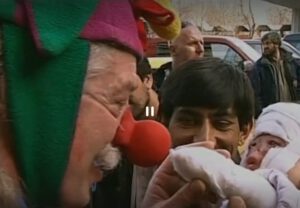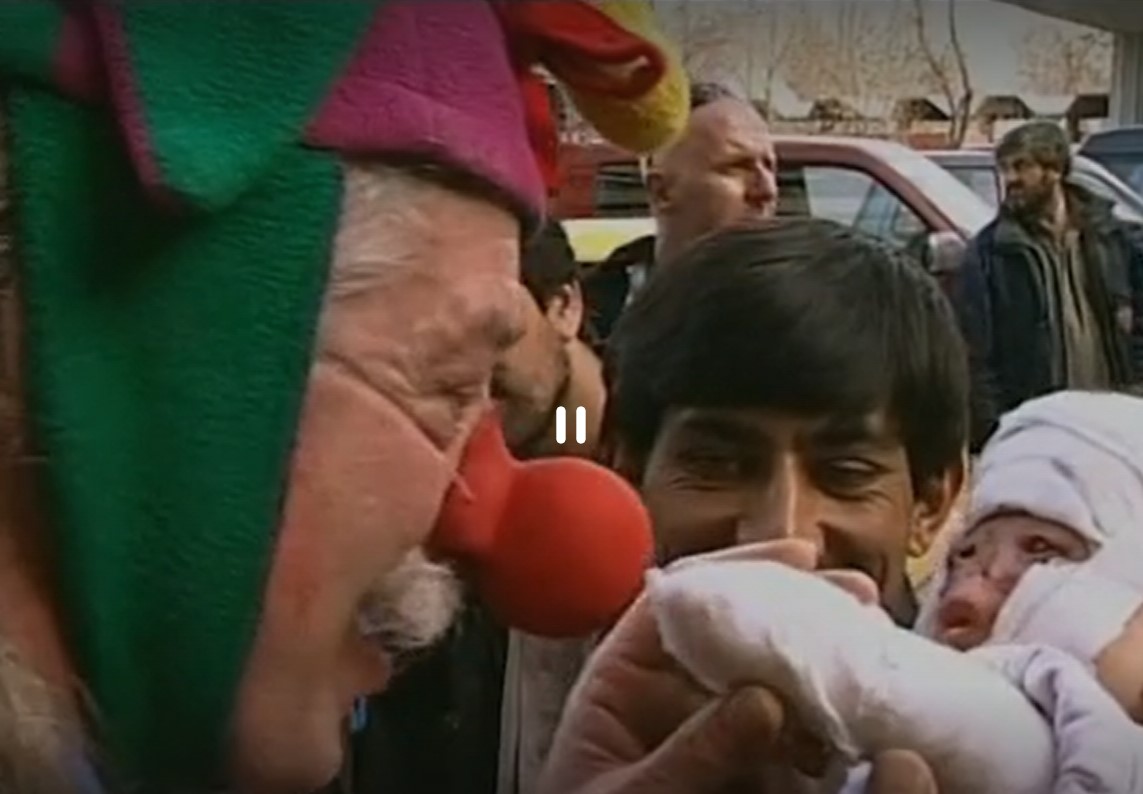Movie Info
Movie Info
- Director
- Enzio Balestrieri and Stefano Moser
- Run Time
- 58 minutes
- Rating
- Not Rated
Relevant Quotes
A glad heart makes a cheerful countenance, but by sorrow of heart the spirit is broken…
All the days of the poor are hard, but a cheerful heart has a continual feast…
A cheerful heart is a good medicine, but a downcast spirit dries up the bones.
Proverbs 15: 13, 15; 17:22A glad heart makes a cheerful countenance, but by sorrow of heart the spirit is broken…
All the days of the poor are hard, but a cheerful heart has a continual feast…
A cheerful heart is a good medicine, but a downcast spirit dries up the bones.
Beloved, let us love one another, because love is from God; everyone who loves is born of God and knows God. Whoever does not love does not know God, for God is love. God’s love was revealed among us in this way: God sent his only Son into the world so that we might live through him. In this is love, not that we loved God but that he loved us and sent his Son to be the atoning sacrifice for our sins. Beloved, since God loved us so much, we also ought to love one another.
For everything there is a season and a time for every matter under heaven:
a time to be born and a time to die;
a time to plant and a time to pluck up what is planted;
a time to kill and a time to heal;
a time to break down and a time to build up;
a time to weep and a time to laugh;
a time to mourn and a time to dance;

I just discovered this Italian documentary about Dr. Patch Adams’ trip to Afghanistan in 2002 with over twenty other clowns and volunteers. I loved the 1999 Robin Williams film Patch Adams based on Adams’ rocky start as a doctor who believed that clowns belonged in hospitals as well as circuses. I have checked on him a few times since and even donated to his Gesundheit Institute, but had no idea about this trip abroad, exporting his healing humor to such a war-torn land. Apparently, it was the city of Rome and humanitarian groups there that produced this delightful film.
It begins with a two-minute segment shot in the Province of Bamyan, among the ruins of the Buddha destroyed by the Taliban. Various peasants walk on the road, some accompanied by donkeys, others herding cattle. We also see the hulks of tanks and other vehicles. The only sound is that of the wind, followed by silence as the front titles appear, then, abruptly, a rapidly sung song breaks forth and we see various clowns dancing and teaching in the city of Rome. Among them is Dr. Patch Adams, dressed in bright colored clothing (but no clown face makeup) giving an anti-establishment speech before a large statue of one of the Caesars. A clown on a cycle declares, “Yes, we are going to Kabul! Yes, we are going to Kabul on our bicycles!”
However, as we see in the next segment, those bicycles, along with the clowns, are aboard a giant four-engine military cargo plane. Many of the clowns are dressed in their brilliant regalia. At the airport the gun-toting Taliban guards are treated to the unusual sight of the colorfully garbed clowns emerging from the plane, while on the soundtrack the circus-associated “Entrance of the Gladiators” blares forth.. As the music continues, cut to a military caravan and then numerous bombed-out buildings and wrecked vehicles, including a bullet-riddled civilian airliner. Cut then to the road where civilians are riding their bicycles, and at last we see the bus transporting the clown troupe to the city. Instead of sitting inside the bus like regular tourists, most of our clowns sit on its roof as they wave their hats and drop off balloons to onlookers. One wonders what those whom they pass must think of this unusual entrance of the visitors. The music ends with the loud clang of a metal locker, the camera taking us inside the crowded corridor of a hospital.
There is no narrator to set up this or any other scene for us, writer/directors Enzio Balestrieri and Stefano Moser letting some of the participants, mostly Dr. Patch Adams himself, comment on what they are doing or have seen. Children, some unconscious, are wheeled by, a cat wanders through the rooms, mothers hold babies crying from their injuries, other children simply stare at the camera. Though in somber contrast to the trip from the airport—the music is equally serious—this montage of children’s images does not cushion us from the shock created by a series of shots of medics tending to the scorched back of a child—there are numerous such shots, often with the child screaming in pain. In one, a closeup (too close!), a medic cuts away the scorched, blackened skin from the young victim’s back! These horrific shots are interspersed with quick shots of the clowns walking up the stairs and trying to distract the crying children and anxious parents with balloons and bubbles and a small stuffed tiger that reminded me of Fred Roger’s Daniel Tiger.
The blackened burns of the screaming children made me want to turn away. Even stop the film. Especially when a female clown walks into the room calling, “Chip, chip, chip” and squeezes a small rubber bird, emitting a squeaky noise. Following her is another female clown playing soothing music on her violin. Judging by the screams of the child and anguished look on he mother’s face, their distractions are not working—and I wondered if the inclusion of these gruesome scenes was not the filmmakers’ (and the clowns) exploitation of the victims’ sufferings.
I am glad I kept watching, for the many following scenes, some in hospitals, some at village gatherings, provide convincing testimony of the compassion of these garishly costumed merrymakers. In several cases we notice their persistence with those whose painful sufferings had kept smiles far away. Continuing their noisy banter, bubble blowing, or balloon folding and giveaways, the clowns do succeed eventually in coaxing a smile from deep within the sufferers. Other children merely have to see one of the pranksters, and there solemnity is quickly replaced by smiles and laughter. A clown in the center of a circle of children chants a song, and the kids respond. He bids them to say “No to War” and “Yes to Peace.” Elsewhere three clowns do a funny dance routine. Some juggle. Others play instruments, such as a recorder or a violin. In an arena two clowns dance on tall stilts. And, of course, there’s bubble blowing and balloon folding. Sometimes a single balloon, batted around in the air, entertains twenty or more children racing to keep the colorful sphere up in the air.
Patch Adams tells his troupe near the beginning of their tour, “…we are pioneers. We have taken the clown out of the circus and placed him in the hospital. And also outside of Kabul in areas that once were war zones, including the place where the Buddhas were destroyed. The filmmakers keep their focus narrowed—nothing of the politics or history of the violence which scarred so many of the victims. (Some of the bombs were set off by native terrorists whose hatred was the very opposite of the love the clowns bring. More than a few of those bombs came from the sky or cannons sent from America. But this you will have to learn from other documentaries.)
Pain and trauma know no politics, but they do respond to love, and these clowns have plenty of that to give away, along with their balloons. Judging by the responses from the crowds wherever they gather, the clowns receive it as well. I have learned by exploring the website of the Gesundheit Institute that this trip to Afghanistan was but one of the many trips that Dr. Adams has led, his first beginning in 1985 to the Soviet Union. He says he goes on six or seven such trips each year, as well as speaking on various aspects of medicine, healing and clowning all round the country. (I just found his FaceBook post in which he talks about the film, mentioning that his brother was one of the participants.)
Although filled with the sad and happy faces of children, this is not a film for the entire family due to a half dozen horrific scenes in which we see what unleashed hatred can do to tiny bodies. But I do urge those concerned for social justice to watch this record of a very unusual approach to suffering and sorrow. You will come away feeling better about this cockyed world filled with tragedy but also with love-based comedy. And, if you are like me, fascinated with comedy and laughter and their relation to faith, this is the movie for you. (I came across it while searching for materials for the workshop I am currently giving, The Gospel and Comedy.) Although some spiritual sourpusses would be offended by the antics of Patch Adams and his merry followers, I think the authors of Proverbs and Ecclesiastes would understand—and join in the laughter
The documentary was available on DVD, but no longer. Fortunately, it can be watched for free on the internet: click on Clown in Kabul.
This review will be in the July issue of VP along with a set of questions for reflection and/or discussion. If you have found reviews on this site helpful, please consider purchasing a subscription or individual issue in The Store.

